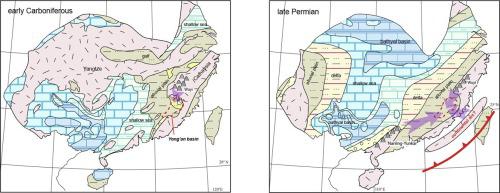Journal of Asian Earth Sciences ( IF 2.7 ) Pub Date : 2021-05-19 , DOI: 10.1016/j.jseaes.2021.104827 Linwei Shen , Jin-Hai Yu , W.L. Griffin

|
Systematic detrital zircon U-Pb dating was applied to Cambrian to Triassic sedimentary rocks in the Yong’an basin, southeastern South China, and yields four age groups. Cambrian and Ordovician quartz schists display prominent Grenvillian (906–1199 Ma) and minor late Neoarchean to earliest Paleoproterozoic (2418–2619 Ma) populations, showing characteristics of an East Gondwanan origin. Devonian and Carboniferous sandstones feature euhedral Neoproterozoic (733–999 Ma) and early Paleozoic (405–468 Ma) detrital zircons, suggestive of a proximal accumulation sourced from the nearby Wuyi terrane. Middle Permian to early Triassic sandstones contain abundant late Paleoproterozoic (1743–1979 Ma), Grenvillian (893–1271 Ma), and early Paleozoic (403–471 Ma) detrital zircons, together with increasing late Paleozoic (264–374 Ma) populations, indicating multiple provenances. Late Triassic sandstones show dominant proportions of late Paleoproterozoic (1805–1938 Ma) zircons, derived mainly from the Wuyi terrane. Three Phanerozoic orogenic events in the South China Block (SCB), i.e. early Paleozoic (Kwangsian or Wuyi-Yunkai), late Paleozoic, and early Mesozoic (Indosinian) orogenies, probably are responsible for the changes in clastic provenance among the four groups of sedimentary rocks. The late Paleozoic orogeny in the SCB was previously thought to be a limited minor event. This study suggests that the impact of late Paleozoic orogenesis on the SCB could be much wider. The uplift of the Wuyi Mountains probably started after the early Paleozoic orogeny, much earlier than previously proposed, and has provided long-term clastic supply to the Yong’an basin and nearby basins.
中文翻译:

寒武系至三叠系沉积岩碎屑成分追踪的华南地块显生宙造山作用
对华南东南部永安盆地寒武系至三叠系沉积岩进行系统碎屑锆石U-Pb定年,得到四个年龄组。寒武纪和奥陶纪石英片岩显示出显着的 Grenvillian (906-1199 Ma) 和少量的晚新太古代到最早的古元古代 (2418-2619 Ma) 种群,显示出东冈瓦纳起源的特征。泥盆纪和石炭纪砂岩具有自形新元古代 (733-999 Ma) 和早古生代 (405-468 Ma) 碎屑锆石,表明近端堆积来自附近的武夷地体。中二叠世至早三叠世砂岩含有丰富的晚古元古代 (1743-1979 Ma)、格伦维尔阶 (893-1271 Ma) 和早古生代 (403-471 Ma) 碎屑锆石,以及增加的晚古生代 (264-374 Ma) 种群,表示多个出处。晚三叠世砂岩显示出晚古元古代(1805-1938 Ma)锆石的主要成分,主要来自武夷地层。华南地块(SCB)的三个显生界造山事件,即早古生代(广西或武夷-云开)、晚古生代和早中生代(印支)造山带,可能是造成四组沉积物碎屑物源变化的原因岩石。SCB 的晚古生代造山运动以前被认为是一个有限的小事件。这项研究表明,晚古生代造山作用对 SCB 的影响可能要广泛得多。武夷山的隆升可能始于早古生代造山运动之后,远早于先前的推测,为永安盆地及附近盆地提供了长期的碎屑供应。晚三叠世砂岩以晚古元古代(1805-1938 Ma)锆石为主,主要来源于武夷地体。华南地块(SCB)的三个显生界造山事件,即早古生代(广西或武夷-云开)、晚古生代和早中生代(印支)造山带,可能是造成四组沉积物碎屑物源变化的原因岩石。SCB 的晚古生代造山运动以前被认为是一个有限的小事件。这项研究表明,晚古生代造山作用对 SCB 的影响可能要广泛得多。武夷山的隆升可能始于早古生代造山运动之后,远早于先前的推测,为永安盆地及附近盆地提供了长期的碎屑供应。晚三叠世砂岩以晚古元古代(1805-1938 Ma)锆石为主,主要来源于武夷地体。华南地块(SCB)的三个显生界造山事件,即早古生代(广西或武夷-云开)、晚古生代和早中生代(印支)造山带,可能是造成四组沉积物碎屑物源变化的原因岩石。SCB 的晚古生代造山运动以前被认为是一个有限的小事件。这项研究表明,晚古生代造山作用对 SCB 的影响可能要广泛得多。武夷山的隆升可能始于早古生代造山运动之后,远早于先前的推测,为永安盆地及附近盆地提供了长期的碎屑供应。










































 京公网安备 11010802027423号
京公网安备 11010802027423号